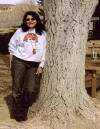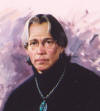|
CURANDERISMO: SOUL MEDICINE FOR DISABILITY
(PART 1) |
|
|
Laurance Johnston, Ph.D. |
|

Used by many Mexican-Americans to
supplement conventional medicine, curanderismo is a
mind-body-spirit healing approach steeped in tradition and ceremony.
Although meant to enhance wellness at many levels, for people with
disabilities, curanderismo especially targets the soul.
Because of the growing societal role Hispanics continue to play, it is
important to integrate culturally attuned methods such as
curanderismo into our healing spectrum.
I receiv ed
training from several leading curanderos, including David
Atekpatzin Young and Elena Avila (photos). Reflecting curanderismo's
mestizo (Spanish and American Indian) origins, Young, hailing from New
Mexico, is of Spanish, Apache, and Pueblo Indian ancestry. Avila,
originally from El Paso, Tex., is of Spanish, Aztec, Mayan, and Zapotec
ancestry. ed
training from several leading curanderos, including David
Atekpatzin Young and Elena Avila (photos). Reflecting curanderismo's
mestizo (Spanish and American Indian) origins, Young, hailing from New
Mexico, is of Spanish, Apache, and Pueblo Indian ancestry. Avila,
originally from El Paso, Tex., is of Spanish, Aztec, Mayan, and Zapotec
ancestry.
Although trained by many traditional folk healers, both
Avila and Young have extensive experience in mainstream healthcare. For
example, Avila has a master’s degree in psychiatric nursing, and Young was
trained as a psychotherapist and ran an organization targeting Native
American health problems. Both believe that curanderismo does not
substitute for but supplements conventional medicine.
Curanderismo was long suppressed,
starting with the Spanish conquistadors, who ruthlessly imposed their
cultural values on indigenous populations. In contemporary times, health
authorities dismissed curanderismo, in part because its philosophy
clashed with modern medicine's core belief that our body parts can be
fixed in isolation of an overriding, integrating soul.
Because of the opposition it faced, curanderismo wisdom was
preserved by being passed down from teacher to apprentice for generations
outside the medical mainstream view - that is until relatively recently,
when people such as Young and Avila stepped forward to bridge the ancient
with the modern. One of the results of this thrust is Avila's book
Woman Who Glows in the Dark.
Many people seeking curanderismo training are conventionally
trained health-care professionals. Although deeply committed to their
healing roles, they believe modern medicine - as shaped by economic,
high-tech, and pharmaceutical concerns - does not foster the deep
relationship they desire with patients. For example, Avila gave up
nursing, in part, because she believed patients, especially Hispanics,
often could not achieve lasting benefits with traditional approaches
alone.
Indigenous Contributions
Curanderismo sprang out of ancient Mesoamerican civilizations, whose
contributions, although largely ignored, have greatly shaped today's
world. For example, many drugs have origins in botanical medicines, and a
huge portion of today's food staples were foods enjoyed by these
civilizations. The inclusion of these edibles significantly improved the
overall nutritional value of the European diet. Given such examples of the
abilities of these contributions to nurture and keep us healthy in today's
world, it follows that their healing principles also have relevance.
Historical Origin
Curanderismo stems from the Spanish word curar, which means to
heal, and is practiced throughout Mexico, Latin America, and the
southwestern United States. Specific procedures may vary depending on
regional influence. For example, what is emphasized in Texas will differ
from practices in northern New Mexico with its unique Native American
influences.
According to curanderismo, disease is caused by social, psychological,
physical, and spiritual factors. A mix of healing traditions, the practice
is grounded in ancient Aztec medicine. When the Spanish conquered the
Aztecs in the early 1500s, they rejected the healing practices that
evolved into curanderismo, partly because they emphasized
non-Christian spirituality. As a result, many spiritual components changed
to forms more palatable for the conqueror's Catholic faith. For example,
anthropologists suggest that that the Virgin of Guadalupe, whose
image is a ubiquitous presence in curanderismo rituals, is a
Christianized version of the Aztec lunar mother goddess Tonantzin.
Over time, Aztec healing traditions were
influenced by Spanish medicine, which itself was shaped by Arabic medicine
practiced by the Moors, who, at the time of the Spanish conquest of
Mexico, had been only recently expelled from the Iberian Peninsula.
Considered the most advanced at the time, Arabic medicine's influences
dated back to Ancient Greece and Egypt and, given the extent of the Arabic
contact into Asia, reflected oriental healing principles. Finally, African
slaves and Native American cultures wove their insights into this
culturally rich healing tapestry we now call curanderismo.
Specialists
Like modern medicine, curanderismo specialists have a don (a
God-given gift) in one or more areas:
A hierbero (herbalist) uses plant remedies to treat disorders and
ailments. For example, chamomile is used to sedate; mint or rosemary for
indigestion; prickly pear cactus or nopal to reduce blood sugar in
diabetics; and cow parsnip to treat injured nerves and stimulate
regeneration. Many fragrant herbs, especially rosemary, are used in
rituals to call in spiritual assistance.
The sobadoro's don is loving-touch massage, which is used for both
physical comfort and reaching out to one's psyche and soul to initiate
higher-level healing.
The partera (midwife) guides expectant mothers. For example, as
discussed in La Partera, Young's aunt assisted in more than 12,000
births in northern New Mexico. A perinatal nurse I spoke to said she
studied curanderismo to be more sensitive to the needs of her
Hispanic clients.
A consejero (counselor) uses heart-to-heart talks called
pláticas to bring up repressed issues or problems that need to be
released before the client can constructively move on in life.
Similar to a chiropractor, a huesero does spinal adjustments and
sets dislocated joints.
An espiritualista channels advice from helpful spirits, such as
Niño Fidencio, a folk-saint healer who died 70 years ago. In her case,
Avila states that when in a trance state, she does not channel any
specific entity but often feels God's energy coming through her.
Finally, some curanderos are energy workers. Believing that our
physical body and all of its defects are secondary to our all-pervasive
energetic nature (energy fields), they sense dysfunctional energy, get rid
of it, and direct beneficial energy to where it is needed, sometimes even
at a distance.
Disorders
Curanderismo treats categories of physical, emotional, or soul
dysfunction. Although defined in a traditional way that seems out of place
compared to modern medicine, all can be interpreted in a broader healing
perspective.
Physical categories include bilis (rage), with ailments aggravated
by our frenetic fight-or-flight lifestyles; empacho (blockage),
associated with digestive disorders, as well as emotional blocks; and
mal aire (bad air), causing ailments in children such as earaches or
chills.
Consistent with scientific studies that suggest that negative
consciousness can adversely affect living systems, traditional emotional
categories of cuaranderismo include envidia (envy); mal
puesto (hex or curse), in which negative energy directed toward a
person creates havoc or disharmony; mal ojo (staring), in which
children become ill because they can not handle excessive adult attention;
and mala suerte (bad luck), in which adversity fuels a
vicious-circle creation of bad luck.
| "Mal ojo describes what I would attribute
to over-stimulation cues, happening due to adult interaction
with the baby who does not recognize the behavioral cues and
then becomes stressed." - RN & Infant Developmental Specialist,
working 36 years, primarily in the Neonatal Intensive Care Unit. |
Susto
For people with disabilities, the most relevant category is susto
(soul loss). With susto, we become blocked from or lose access to
aspects of our higher self that are needed for healing. Because we all
face in life, as Shakespeare said, "the slings and arrows of outrageous
fortune," we all experience susto. You lose a job, your wife leaves
you, or a parent dies-you have susto. We define ourselves with
certain "who-am-I?" criteria, and when life's inevitable entropy destroys
them, we lose aspects of our soul.
Because severe disability has so much potential to distort one's
self-perception, susto is an important factor when a person becomes
paralyzed through injury or disease. For example, if a macho veteran
becomes sexually impotent due to multiple sclerosis (MS) or an athlete
sustains a spinal-cord injury (SCI), his self-definition may be so altered
that physical and mental healing will be compromised unless susto
is addressed.
Avila's book discusses several men with severe mobility-affecting
disabilities. In one case, a double amputee, believing his soul had died
in Vietnam, became a substance abuser and attempted suicide. In another
case, a person with disabilities from childhood polio had long-term
resentment that was being held back. This adversely affected the person's
relationships and employment situation.
Part 2 will discuss procedures and ceremonial rituals that deal with
susto. Curanderismo may not bring about physical healing through
physiological changes but promotes healing via improved quality of life,
happiness, and self-understanding.
|
CURANDERISMO
READING
Because a short, descriptive article
can not adequately reflect the strength, heart, and soul of
curanderismo, readers are encouraged to consult these books:
Woman Who Glows in the Dark: A Curandera Reveals Traditional Aztec
Secrets of Physical and Spiritual Health, by Elena Avila, R.N.,
M.S.N. with Joy Parker.
Curandero: A Life in
Mexican Folk Healing, by
Eliseo "Cheo" Torres with Timothy L. Sawyer Jr.
Curanderismo: Mexican American Folk Healing, by Robert T.
Trotter II, Juan Antonia Chavira.
Healing with Herbs and Rituals: A Mexican Tradition, by Eliseo
"Cheo" Torres with Timothy L. Sawyer Jr.
La Partera, by Fran Leeper Buss.
Bless Me, Ultima, by Rudolfo Anaya. |
Adapted from article appearing in
June 2006 Paraplegia News (For subscriptions,
call 602-224-0500) or go to
www.pn-magazine.com.
TOP |
| |
| |
|
| |
| |
|
| |
|
|
|